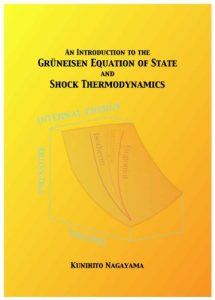This is a monograph on the Grüneisen equation of state basically used for condensed substance at high pressures and temperatures. The Grüneisen type equation of state, in a wide sense, has been used for a long time in high-pressure physics or in shock wave physics and detonation physics especially for condensed media. This book covers most of the works of the author on this EOS and its application to several dynamic problems including shock wave propagation. Thermodynamic definition of the Grüneisen parameter is a non-dimensional parameter characteristic of an aspect of materials mechanical degrees of freedom. A strong constraint on the interrelationship between the Grüneisen parameter and the specific heat at constant volume is emphasized resulting from the thermodynamic formulation of the equation of state.
New thermal variables have been derived to describe the compressed state of condensed substance attained by the application of high pressure. Thermodynamic formulation based on new variables has been developed for idealized Debye solids, anharmonic solids, and three-term EOS for solids at extremely high pressures and temperatures. Possibility of the law of corresponding states concerning a new thermal variable has been pursued. Based on the three theoretical models on the relationship between cold pressure and the Grüneisen parameter, a numerical procedure is proposed to estimate the volume dependence of the Grüneisen parameter. Numerical examples are presented to discuss the results on the Grüneisen parameter and cold potential energy function by comparing them with DAC data and/or first principle based theoretical calculations. All the above treatments rely on the high-pressure shock wave data, and precise shock wave physics discussion has been described in this book.
Shock wave compression provides appreciable irreversible heating as well as appreciable volume compression. Importance of shock wave data is due to the fact that shock Hugoniot compression curve is a most reliable succession of high-pressure states on the state surface of the substance. Detailed discussions on the shock compression, shock Hugoniot, irreversible heating together with the estimation of shock Hugoniot states based on the Grüneisen equation of state have been made. As one of the important applications of the Grüneisen type equation of state, detonation of condensed high explosives is described. Several topics such as the Grüneisen type equation of state for detonation product gases inferred from the initial density dependence of the detonation velocity, two-Debye temperature solids as a model for the unreacted energetic materials, etc have been described. And finally, some of the flow problems including shock wave propagation, i.e., Tait type equation of state to describe water shock dynamics, symmetric shock flow in condensed media, and solution of the Riemann problems, have been described.
This book totally ignores the following important topics such as high-pressure polymorphic transformation and elastic-plastic transition. They are interesting topics in shock wave science and readers can find excellent books or reviews on these subjects. The reason why these are omitted is simply because the author has no appreciable contributions to this area. In this sense, we stick to hydrostatic pressure in the realm of equilibrium thermodynamics where the equation of state is defined.
New thermal variables have been derived to describe the compressed state of condensed substance attained by the application of high pressure. Thermodynamic formulation based on new variables has been developed for idealized Debye solids, anharmonic solids, and three-term EOS for solids at extremely high pressures and temperatures. Possibility of the law of corresponding states concerning a new thermal variable has been pursued. Based on the three theoretical models on the relationship between cold pressure and the Grüneisen parameter, a numerical procedure is proposed to estimate the volume dependence of the Grüneisen parameter. Numerical examples are presented to discuss the results on the Grüneisen parameter and cold potential energy function by comparing them with DAC data and/or first principle based theoretical calculations. All the above treatments rely on the high-pressure shock wave data, and precise shock wave physics discussion has been described in this book.
Shock wave compression provides appreciable irreversible heating as well as appreciable volume compression. Importance of shock wave data is due to the fact that shock Hugoniot compression curve is a most reliable succession of high-pressure states on the state surface of the substance. Detailed discussions on the shock compression, shock Hugoniot, irreversible heating together with the estimation of shock Hugoniot states based on the Grüneisen equation of state have been made. As one of the important applications of the Grüneisen type equation of state, detonation of condensed high explosives is described. Several topics such as the Grüneisen type equation of state for detonation product gases inferred from the initial density dependence of the detonation velocity, two-Debye temperature solids as a model for the unreacted energetic materials, etc have been described. And finally, some of the flow problems including shock wave propagation, i.e., Tait type equation of state to describe water shock dynamics, symmetric shock flow in condensed media, and solution of the Riemann problems, have been described.
This book totally ignores the following important topics such as high-pressure polymorphic transformation and elastic-plastic transition. They are interesting topics in shock wave science and readers can find excellent books or reviews on these subjects. The reason why these are omitted is simply because the author has no appreciable contributions to this area. In this sense, we stick to hydrostatic pressure in the realm of equilibrium thermodynamics where the equation of state is defined.






